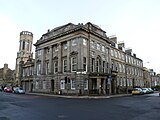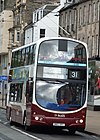Constitution Street
Coordinates: 55°58′23″N 3°10′06″W / 55.97306°N 3.16833°W

Constitution Street is a thoroughfare in Leith, Edinburgh, Scotland. It runs north from the junction of Leith Walk, Great Junction Street and to Leith docks.
The street takes its name from Constitution Hill, which stood on the site of the current .[1] The road was only completed in 1800, at that time being built as a bypass from Bernard Street to Leith Walk, avoiding the crowded and twisting medieval streets of old Leith. The street at that time was causewayed, rising around two metres above natural ground level. Buildings which predate this now have their original fine ground floor rooms buried at basement level.
Constitution Street was to form part of the Edinburgh Trams network and much preparatory work was carried out but the Leith section of the project has been postponed with no date given for completion.
Notable events[]
On 9 January 1823 the last two men executed for piracy in Scotland were hanged at the north end of the street (near what is now Tower Street). The two men were Peter Heaman from Sweden and Francois Gautiez from France. They were found guilty in the summer of 1822 of capturing the brig "Jane", en route from Gibraltar to Brazil, killing its master and stealing 38,000 Spanish dollars.[2] One account says their bodies were afterwards awarded to Dr Robert Knox for dissection.[3] A second account says they were buried where executed. Two bodies were discovered during an archaeological dig at the north end of the street in approximately the correct area in the summer of 2000, possibly validating the latter claim.
Notable buildings[]
South of Bernard Street, the most notable building is the classical Assembly Rooms, the former Leith Exchange building.
Leith Police Station, formerly Leith Town Hall, built in 1827 to a design by R & R Dickson.[4]
Church of St.James was designed by George Gilbert Scott, built in 1862. The stone spire was truncated in 1977.[5]
The churchyard belongs to South Leith Parish Church The churchyard was only used for burial from the mid 17th century, earlier interments being inside the church, beneath the parishioners usual seating position (or threaded in the rafters if you had a balcony position). In 2009, an excavation linked to the construction of Edinburgh Trams unearthed several bodies just outside the churchyard wall.[6]

Exchange Buildings and Assembly Rooms

Leith Police Station, originally Leith Town Hall, 1827

Former Church of St. James

South Leith Parish Church
References[]
- ^ Plan of Leith 1777
- ^ "Execution". National Library of Scotland. Retrieved 28 January 2021.
- ^ Grant, James A. (1881–1883). Cassell's Old and New Edinburgh: Its History, its people and its places. Vol. VI. London: Cassell & Company. p. 243.
- ^ Dictionary of Scottish Architects: Dickson
- ^ "St James's Episcopal Church and Hall (Former), 119, Constitution Street, Leith | Buildings at Risk Register". www.buildingsatrisk.org.uk. Retrieved 3 June 2020.
- ^ "Tram workers unearth human remains". The Scotsman.
- Streets in Edinburgh
- Leith








